Overview¶
Introduction
k-Nearest Neighbors
Decision Tree
Support Vector Machine
Multilayer Perceptron
Deep Learning
Recommended prerequisite knowledge¶
Linear algebra
Calculus
Python
# numpy and matplotlib will be used a lot during the lecture
# if you are familiar with these libraries you may skip this part
# if not - extended comments were added to make it easier to understand
# it is kind of standard to import numpy as np and pyplot as plt
import numpy as np
import matplotlib.pyplot as plt
# used later to apply different colors in for loops
mpl_colors = ('r', 'b', 'g', 'c', 'm', 'y', 'k', 'w')
# just to overwrite default colab style
plt.style.use('default')
def generate_random_points(size=10, low=0, high=1):
"""Generate a set of random 2D points
size -- number of points to generate
low -- min value
high -- max value
"""
# random_sample([size]) returns random numbers with shape defined by size
# e.g.
# >>> np.random.random_sample((2, 3))
#
# array([[ 0.44013807, 0.77358569, 0.64338619],
# [ 0.54363868, 0.31855232, 0.16791031]])
#
return (high - low) * np.random.random_sample((size, 2)) + low
def init_plot(x_range=None, y_range=None, x_label="$x_1$", y_label="$x_2$"):
"""Set axes limits and labels
x_range -- [min x, max x]
y_range -- [min y, max y]
x_label -- string
y_label -- string
"""
# subplots returns figure and axes
# (in general you may want many axes on one figure)
# we do not need fig here
# but we will apply changes (including adding points) to axes
_, ax = plt.subplots(dpi=70)
# set grid style and color
ax.grid(c='0.70', linestyle=':')
# set axes limits (x_range and y_range is a list with two elements)
ax.set_xlim(x_range)
ax.set_ylim(y_range)
# set axes labels
ax.set_xlabel(x_label)
ax.set_ylabel(y_label)
# return axes so we can continue modyfing them later
return ax
def plot_random_points(style=None, color=None):
"""Generate and plot two (separated) sets of random points
style -- latter group points style (default as first)
color -- latter group color (default as first)
"""
# create a plot with x and y ranges from 0 to 2.5
ax = init_plot([0, 2.5], [0, 2.5])
# add two different sets of random points
# first set = 5 points from [0.5, 1.0]x[0.5, 1.0]
# second set = 5 points from [1.5, 2.0]x[1.5, 2.0]
# generate_random_points return a numpy array in the format like
# [[x1, y1], [x2, y2], ..., [xn, yn]]
# pyplot.plt take separately arrays with X and Y, like
# plot([x1, x2, x3], [y1, y2, y3])
# thus, we transpose numpy array to the format
# [[x1, x2, ..., xn], [y1, y2, ..., yn]]
# and unpack it with *
ax.plot(*generate_random_points(5, 0.5, 1.0).T, 'ro')
ax.plot(*generate_random_points(5, 1.5, 2.0).T, style or 'ro')
return ax
def plot_an_example(style=None, color=None, label="Class"):
"""Plot an example of supervised or unsupervised learning"""
ax = plot_random_points(style, color)
# circle areas related to each set of points
# pyplot.Circle((x, y), r); (x, y) - the center of a circle; r - radius
# lw - line width
ax.add_artist(plt.Circle((0.75, 0.75), 0.5, fill=0, color='r', lw=2))
ax.add_artist(plt.Circle((1.75, 1.75), 0.5, fill=0, color=color or 'r', lw=2))
# put group labels
# pyplot.text just put arbitrary text in given coordinates
ax.text(0.65, 1.4, label + " I", fontdict={'color': 'r'})
ax.text(1.65, 1.1, label + " II", fontdict={'color': color or 'r'})Introduction¶
What is machine learning?¶
+-------------------------------------------------------------------------+
| |
| Any technique which enables |
| computers to mimic human Artificial Intelligence |
| intelligence |
| |
| +-------------------------------------------------------------------+
| | |
| | Statistical techniques which |
| | enable computers to improve Machine Learning |
| | with experience (subset of AI) |
| | |
| | +-----------------------------------------------------------+
| | | |
| | | Subset of ML which makes |
| | | the computations using Deep Learning |
| | | multi-layer neural networks |
| | | |
+-----+-------+-----------------------------------------------------------+Supervised learning¶
Problems: classification, regression
Let be feature vectors
Let be class labels
Let be hypothesis
Find given training examples
plot_an_example(style='bs', color='b');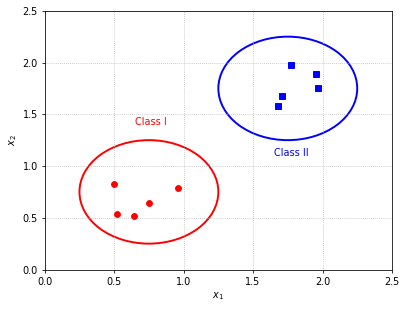
Unsupervised learning¶
In opposite to supervised learning data is not labeled
Problems: clustering, association
For example: k-means clustering, self-organizing maps
plot_an_example(label="Cluster");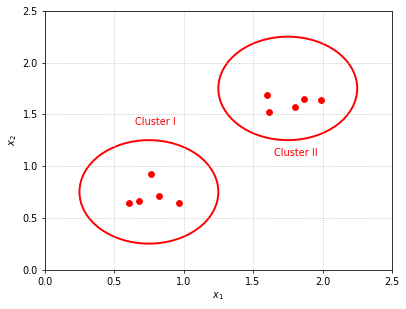
Example: Supervised vs Unsupervised¶
Having photos of different animals
Supervised task (requires labeled data)
Train an algorithm to recognise given species on a photo.
Output: There is X on a photo.
- Unsupervised task
Train an algorithm to group animals with similar features.
Output: No idea what it is, but it looks similar to these animals.
Reinforcement learning¶
+---------+
| |
+--------+ AGENT | <------+
| | | |
| +---------+ |
| | Observation
Action | |
| | Reward
| +---------------+ |
| | | |
+---> | ENVIRONMENT +-----+
| |
+---------------+ML applications¶
Image recognition
Google Maps - finding licence plates and faces; extracting street names and building numbers
Facebook - recognising similar faces
Speech recognition
Natural Language Processing
Google Translate - machine translation
Next Game of Thrones Book - language modeling
Misc
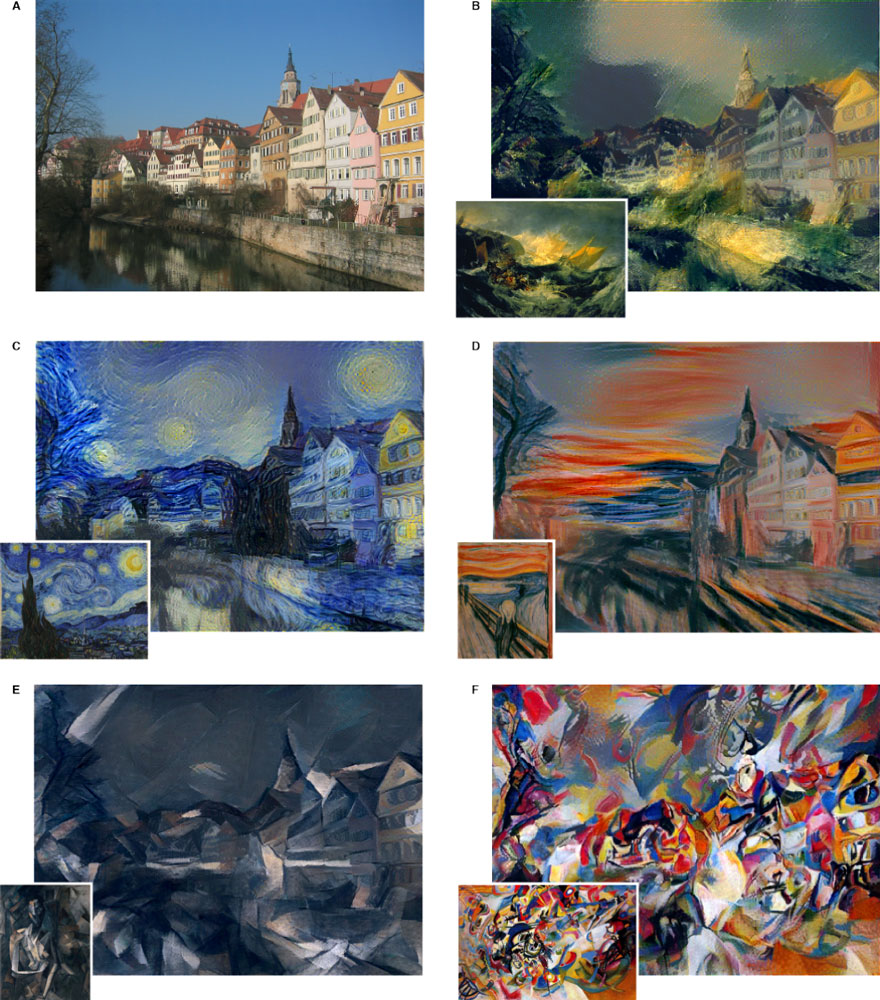
ML Fails¶
Amazon’s Alexa - TV broadcast caused many orders around San Diego when presenter said I love the little girl, saying ‘Alexa ordered me a dollhouse’.
Amazon’s Alexa - when a kid asked for his favorite song Digger, Digger Alexa’s respond was: You want to hear a station for porn detected … hot chick amateur girl sexy.
Microsoft’s Tay chatbot learned from tweets how to be racist
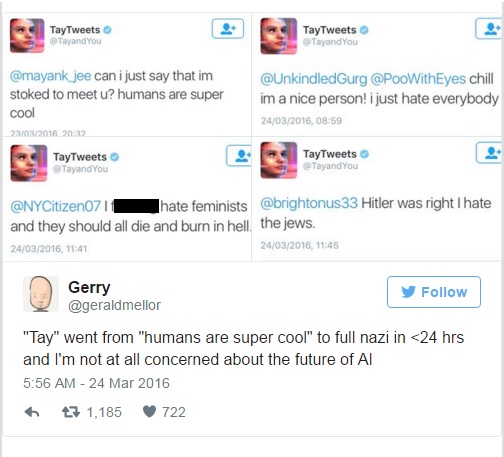
- Passport checker rejects Asian’s photo because eyes are closed
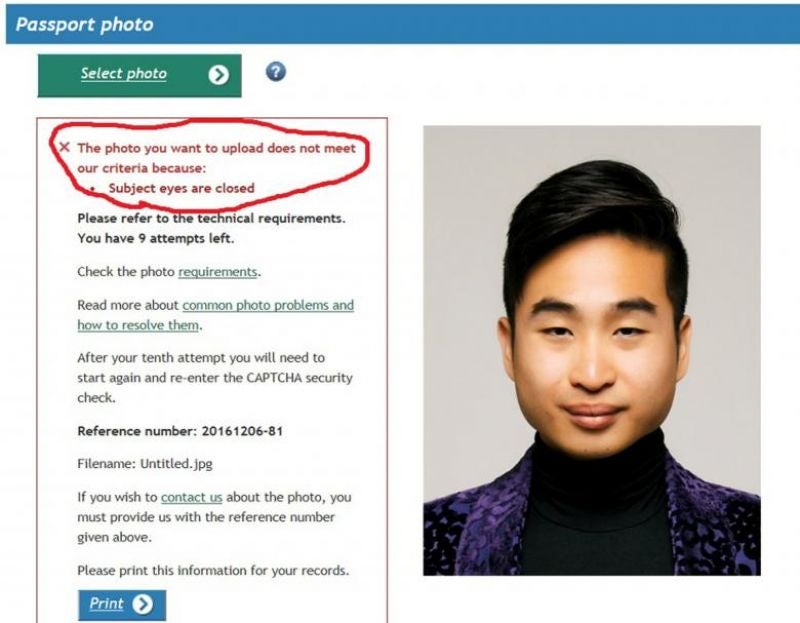
- So make sure you can not relate to this
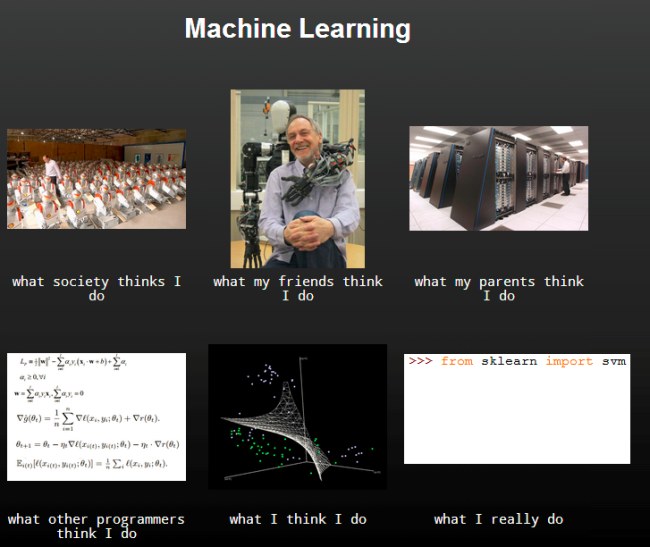
ML Frameworks¶
Tensorflow by Google - Python (and somewhat in C/C++)
Caffe by Berkeley Vision and Learning Center - C/C++, Python, MATLAB, Command line interface
Torch by many - Lua and C/C++
Theano by University of Montreal - Python (development stopped in 2017)
scikit-learn by many - Python
and many others